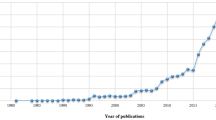Abstract
It is shown that Data Envelopment Analysis (DEA) ca be used to construct relative scientific and technological indicators. The method is explained and illustrated using countries as objects of study; GDP, active population and R&D expenditure as inputs, and publications and patents as outputs. Using these parameters the efficiency of countries is assessed.
Similar content being viewed by others
References
S. A. Raymond (Ed.),Science-based economic development, Annals of the New York Academy of Sciences, vol. 798. The New York Academy of Sciences, New York, 1997.
A. N. Link, Economic performance measures for evaluating government-sponsored research,Scientometrics, 36 (1996) 325–342.
M. J. Farrell, The measurement of productive efficiency,Journal of the Royal Statistical Society, 120 (1975) 253–281.
A. Charnes, W. W. Cooper, E. Rhodes, Measuring the efficiency of decision making units,European Journal of Operations Research, 2(6) (1978) 429–444.
A. Charnes, W. W. Cooper,Management Models and Industrial Applications of Linear Programming. Wiley, New York, 1961 (Chapter IX).
A. Charnes, W. W. Cooper, Preface to topics in data envelopment analysis,Annals of Operations Research, 2 (1985) 59–94.
M. Norman, B. Stoker,Data Envelopment Analysis: The Assessment of Performance, Wiley & Sons, Chicester, 1991.
H. D. Sherman, Data envelopment analysis as a new managerial audit methodology—test and evaluation,Auditing: a Journal of Practice and Theory, 4 (1984) 35–53.
Z. Degraeve, M. Lambrechts, V. Van Puyenbroeck, Een vergelijkende prestatiestudie van de departmenten van de Katholieke Universiteit Leuven.Tijdschrift voor Economie en Management, 41 (1996) 165–193.
W. L. Winston,Operations Research. Applications and Algorithms, (3rd ed.), Duxburry Press, Belmont (CA), 1994.
L. Egghe, R. Rousseau,Introduction to Informetrics. Quantitative Methods in Library, Documentation and Information Science, Elsevier, Amsterdam, 1990.
D. H. Kraft, B. R. Boyce,Operations Research for Libraries and Information Agencies: Techniques for the Evaluation of Management Decision Alternatives, Academic Press: San Diego [etc.], 1991.
K. Cunningham, L. Schrage,LINGO: An Optimization Modeling Language, LINDO Systems, Chicago, 1992.
A. Schubert, A. Telcs, Publication potential—an indicator of scientific strength for cross-national comparisons.Scientometrics, 9 (1986) 231–238.
F. Narin, K. S. Hamilton, Bibliometric performance measures,Scientometrics, 36 (1996) 293–310.
J. Anderson, P. M. D. Collins, J. Irvine, P. A. Isard, B. R. Martin, F. Narin, K. Stevens, Online approaches to measuring national scientific output: a cautionary tale,Science and Public Policy, 15 (1988) 153–161.
European Patent Office,Annual Report 1993. München-Den Haag-Berlin-Wien.
United Nations,Statistical Yearbook, 40th issue, New York, 1995.
R. M. May, The scientific wealth of nations.Science, 275 (1997) 793–796.
R. N. Kostoff, Performance measures for government-sponsored research: overview and background,Scientometrics, 36 (1996) 281–292.
A. Schubert, T. Braun, Cross-field normalization of scientometric indicators,Scientometrics, 36 (1996) 311–324.
Author information
Authors and Affiliations
Rights and permissions
About this article
Cite this article
Rousseau, S., Rousseau, R. Data envelopment analysis as a tool for constructing scientometric indicators. Scientometrics 40, 45–56 (1997). https://doi.org/10.1007/BF02459261
Received:
Issue Date:
DOI: https://doi.org/10.1007/BF02459261




